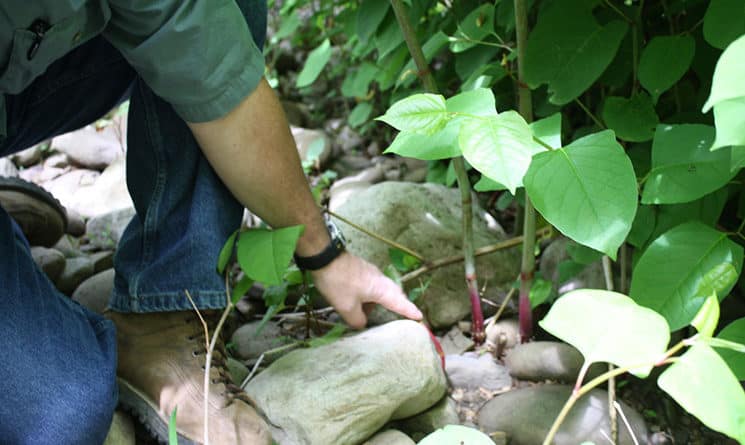Japanese knotweed is a very aggressive perennial that can grow up to 10 feet high and wide. It has a large creeping mass of roots that can spread laterally up to 65 feet away from the crown. The stems are hollow with joints (nodes); the older stems tend to get woody near the base. If any damage to the shoots occurs, this plant can rebound quickly, making it difficult to control. The growing season is from April to October. This plant is usually found near roadsides, along riverbanks, and wetlands. The environmental impacts can include loss of diversity of native plants and erosion of streams or riverbanks.
Control methods
The N.H. Department of Agriculture, Division of Plant Industry suggests two control methods. Please note: Do not mow.
A) Smothering technique
Allow the plant to grow in the spring. Around the first week of June, cut the knotweed at the base, close to the ground. Place these cut stems on a tarp, plastic, or pavement and allow to dry and turn brown. They can be composted if desired. Place mulch, grass clippings, or straw over the cut stems that are protruding from the ground. Cover the entire plant with a big, heavy-duty, dark-colored plastic tarp. If more than one piece is used, make sure the seams overlap by 2 feet. The tarp must extend at least 5-10 feet beyond the limit of the plant. Place weighted materials on top of the tarp such as sand, rocks, wood chips, mulch, etc., being careful not to tear or puncture the tarp. If the tarp is compromised, the knotweed could survive. This tarp needs to stay over the plant for five years. This technique has been successful and is the preferred method for areas near streams and wetlands.
B) Foliar herbicide treatment
Allow the knotweed to grow in the spring. Cut the knotweed stems to the ground during the first week of June. Place the cut stems on a tarp, plastic, or pavement and allow to dry and turn brown. These stems can be composted if desired. Allow the knotweed to re-sprout and allow the plant to flower, which will occur early to mid-September. Honeybees are attracted to the flowers, so wait to treat until just after the flowers fade. Treat before seed production starts, which is usually from September to October. Apply an herbicide, spraying on all foliage until wet but not to the point of runoff. As with all pesticides, read and follow the product label.
*If re-sprouting occurs the following year, retreat using the guidelines above.
Please note that restrictions are in place for applying herbicides within certain distances of water bodies protected under the Shoreland Water Quality Protection Act. Details and answers to frequently asked questions can be found on the N.H. Department of Environmental Services website.
The UNH Cooperative Extension Education Center answers questions about gardening and more at answers@unh.edu, or by calling 877-398-4769, Monday through Friday, between 9 a.m. and 2 p.m.

